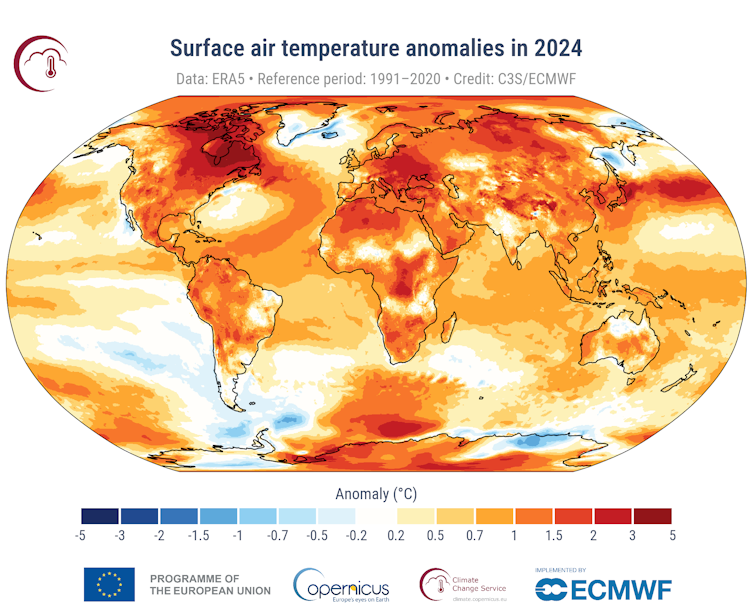As the earth warms, so do the oceans.
Following a record-breaking 2023, 2024 was the warmest year on record for the global ocean. In fact, every decade since satellite records of ocean temperatures began in 1984 has been warmer than the previous one.
Warming oceans mean increased evaporation, which leads to more rainfall in some areas and drought in others. It can power hurricanes and torrential downpours. It can also harm the health of coastal ocean areas and marine life - coral reefs suffered the largest bleaching event on record in 2024, with damage occurring in many parts of the world.
Warming ocean waters also affect land temperatures by changing weather patterns. The European Union's Copernicus Climate Change Service announced on January 10 that data showed that 2024 also broke the record for the world's hottest year, with global temperatures about 2.9 degrees Fahrenheit (1.6 degrees Celsius) higher than pre-industrial times. It would mark the first year in which average temperatures have risen above 1.5 degrees Celsius, a level countries have agreed to avoid exceeding in the long term.

Overall, climate change is to blame. Greenhouse gases released into the atmosphere trap heat, and about 90% of the excess heat produced by emissions from burning fossil fuels and other human activities is absorbed by the oceans.
Although it's clear the ocean has been warming for quite some time, the past two years have been much warmer than in previous decades. This leaves scientists with two mysteries.
It's not just El Niño
The cyclical climate pattern of the El Niño Southern Oscillation could partially explain the warmth of the past two years.
During El Niño, warm water that normally accumulates in the western equatorial Pacific moves eastward toward the coastlines of Peru and Chile, warming the Earth slightly overall. The most recent El Niño began in 2023, causing average global temperatures to rise until early 2024.

But ocean temperatures are even warmer than scientists expected. For example, global temperatures in 2023-2024 follow a similar pattern of increases and decreases across seasons as the last El Niño event (2015-2016), but will be about 0.36 degrees Fahrenheit (0.2 degrees Celsius) higher at all times in 2023-2024 .
Scientists are confused and left with two questions to solve. They must figure out whether other factors are causing the unexpected warming, and whether the past two years are a sign of a sudden acceleration in global warming.
The role of aerosols
One interesting idea tested using climate models is that the rapid decline in aerosols over the past decade could be one of the culprits.
Aerosols are solid and liquid particles emitted into the atmosphere by human and natural sources. Some of these have been shown to partially offset the effects of greenhouse gases by reflecting solar radiation back into space. However, they are also responsible for poor air quality and air pollution.
Many particles with cooling properties are produced during the burning of fossil fuels. For example, ship engines and power plants emit sulfur aerosols. In 2020, the shipping industry implemented nearly 80% reduction in sulfur emissions, with many companies switching to low-sulfur fuels. But the bigger impact will come from reducing emissions from power plants, including China's major shift in that direction. So while technology has reduced these harmful emissions, it means the brakes on slowing warming have been weakened.
Is this a warming wave?
The second puzzle is whether the Earth is experiencing a wave of warming.
Temperatures are clearly rising, but not enough over the past two years to support the idea that we may see an acceleration in the rate of global warming.
Analysis of four temperature data sets covering the period 1850 to 2023 shows that the rate of warming has not changed significantly since around the 1970s. However, the same authors note that a statistically significant acceleration in warming is only detectable if it increases by at least 55% (about half a degree Celsius and nearly Fahrenheit) in one year.
Therefore, from a statistical perspective, scientists cannot rule out the possibility that the record ocean warming in 2023-2024 is simply due to the "usual" warming trend humans have brought to the planet over the past 50 years . A very strong El Niño caused some natural changes.
From a practical perspective, however, the extraordinary impacts experienced by the planet - including extreme weather, heat waves, wildfires, coral bleaching and ecosystem destruction - demonstrate the need for rapid reductions in CO2 emissions to limit ocean warming, whether or not this It is due to the continuation or acceleration of an ongoing trend.
This article has been updated with 2024 global temperature data from the Copernicus Climate Change Service.